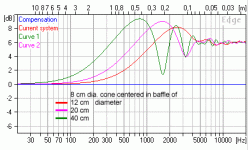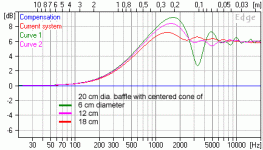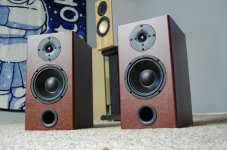I've heard them and thought they were nothing special. What's your point?
You thought they were nothing special? Never mind then. If I knew that, I never would have brought it up. Stupid me..
Seriously though, in the grand scheme of what a normal room can do to a speaker's response, maybe most serious professional designers consider it nothing more than a hairsplitting gimmick.
http://www.atcloudspeakers.co.uk/product.php
Yes, ATC does offset in some, but not all of their designs.. No (large radius) rounding though..
Last edited:
I don't think that smoothing is a good word to use here. What happens is the wavefront is diffracted in such a way that the newly generated "echoes" (at edges, etc.) are spread out in time (which gives them different phase angles) such that they do not interfere (constructively or destructively) to any significant amount with the direct sound at the listening position. It's the interference with the direct sound that is causing the peaks and dips, the ripples, in the frequency response.
As the wavefront encounters and then sweeps along and past the edge(s) it continuously diffracts. If you can make the "encounters" with the edge spread out in time (e.g. not the same distance from the source) as much as possible, then you have spread out the diffraction as well. Note that you can also tilt the baffle to do this for higher frequencies, because this will influence the distances between the source, diffracting edge, and the listening position.
So, with that said, there are not discrete sets of "response echoes" but rather a continuous distribution of them. The distribution can be stretched in several ways - by a large roundover, or by distributing in space the distances between the source and sharp edges. This applies equally to both the vertical and the horizontal axes, everywhere in front radiation hemisphere.
-Charlie
The two situations - roundover and the "spread out" of diffraction that you refer to from varying path lengths (which is correct by the way) are not equivalent. In one case there is lessor diffraction at all frequencies and in the other it is lessened at any one frequency but it occurs across a wider range of frequencies. This is not the same thing. The evidence suggests that it is the area (under the curve) of the effect that is most audible and the area of the effect is significantly different in these two cases - hopefully approaching zero for the roundover.
I wanted to mention as well that the data suggests that the audibility of diffraction is strongly dependent on playback level - becoming more audible at higher levels than lower ones. Hence the listening level becomes important. One cannot compare two speakers at one level and assume that the effects that you hear or don't hear will be the same at higher levels. One thing that is clearly evident from a well designed set of loudspeaers is how high in SPL they play without the usual "smear" in the sound. Most people attribute this to "nonlinear distortion", except that there is no evidence of that (in fact it is clearly refuted by the evidence). I attribute it to diffraction - there is evidence of that.
Last edited:
Ok, Acoustic benefits aside, if most if not all off the big boys are doing it, from a marketing standpoint, why would middle to lower end lines of speakers not do it?
How do they justify not doing it?
As Earl already told you, finish.
Well, Doc, how do we get these fine folks off the computer repeating advertisements and just build a couple prototypes?
Inch and a half eh?
Inch and a half eh?
It's all about education. Someone once asked me how I thought that I could compete in a market dominated by marketing hype, I responded "Educate them to know the difference." What else is there? What else can anyone do?
As Earl already told you, finish.
Sure, but as I posted earlier.....
One could simply roundover of chamfer the sides of the box and leave the top and bottom flat. Then there would be no problem wrapping veneer around it and joining at the back.
Then separate veneer for the top and bottom, cut to fit.
This is not something that I have heard of before now. Intuitively to me, I would think that it is the reverse of what you describe and that maximizing the pathlength distribution (to edges) would result in a wide-band effect whereas the roundover would only be effective above frequencies where its dimension becomes significant compared to the wavelength. Can you point me to any articles/papers/studies where this has been demonstrated? JAES, etc.?The two situations - roundover and the "spread out" of diffraction that you refer to from varying path lengths (which is correct by the way) are not equivalent. In one case there is lessor diffraction at all frequencies and in the other it is lessened at any one frequency but it occurs across a wider range of frequencies. This is not the same thing. The evidence suggests that it is the area (under the curve) of the effect that is most audible and the area of the effect is significantly different in these two cases - hopefully approaching zero for the roundover.
Again, new to me. I am not in any way refuting what you say, only that this goes against my understanding of the phenomena at work here...I wanted to mention as well that the data suggests that the audibility of diffraction is strongly dependent on playback level - becoming more audible at higher levels than lower ones. Hence the listening level becomes important. One cannot compare two speakers at one level and assume that the effects that you hear or don't hear will be the same at higher levels. One thing that is clearly evident from a well designed set of loudspeaers is how high in SPL they play without the usual "smear" in the sound. Most people attribute this to "nonlinear distortion", except that there is no evidence of that (in fact it is clearly refuted by the evidence). I attribute it to diffraction - there is evidence of that.
What is this "evidence" that you mentioned above???
Are you at AES in SF? You can come by the Burning Amp festival (taking place this Sunday also in SF) and see some loudspeakers that I have built to test various ideas. All monopole direct radiator. It would great to have a discussion about this in person... I will be in the "Hertz" room.
-Charlie
Getting back to those graphs that JIKO posted. Is it just me, or does the chamfer look better than the radius?
.... simply roundover of chamfer the sides of the box and leave the top and bottom flat. Then there would be no problem wrapping veneer around it and joining at the back.
reminds me of Infinity
Last edited:
Either keep the baffle as narrow as possible or make the driver as large as possible.
bigger baffle does appear to be much worse
but are you forgetting that diffraction problems also moves down in frequency
I guess its only natural it looks smaller at higher frequencies
but could still be worse, no ? 😕
I don't argue for smaller or wider baffles, but for keeping the distance between driver edge and baffle edge small. If you need a wide baffle for some reason - just do it. But don't put a small driver on it.
Sure, but as I posted earlier.....
One could simply roundover of chamfer the sides of the box and leave the top and bottom flat. Then there would be no problem wrapping veneer around it and joining at the back.
Then separate veneer for the top and bottom, cut to fit.
Many do. It helps about half way, and that may be enough for many. With a floor standing tower, you duck the bottom edge being a problem and unless you are using a full-range, which many of you know I contend does not exist, and that darn mid to tweeter interface is just plain a problem. I remember some testing a long time ago that showed a block of felt between the drivers helped. I have not had time to try that. Very low WAF.
What makes you think the top edge is less important than the side edge?
Another production solution is what Theil does in the CS2 range. ( paint the baffle, wood sides ) Look at their CS3 range and of course the B&W 800 series. B&W can only do this with their mega-bucks and very high numbers. It would be very hard for a DIY or even a small production company.
I should make this my signature block: "Your results may vary, PROTOTYPE"
Off to breakfast and to watch people rush to the store to buy milk and bread because a storm is coming. Quite funny here in Maryland. I did goof last time when power was out for a week and I had no gas in my car to go far enough to buy gas for my generator.
Some of the most highly regarded, anechoically(true) designed loudspeakers in the world. Harbeth UK Roundover and offset? Hmm.. Makes you think..
Harbeth has focused on cabin damping, as well as (vibration-wise) decouple front and rear baffle from the four remaining side panels. Both strategies are following results from published BBC studies .
George
Grimm AudioAre you at AES in SF? You can come by the Burning Amp festival (taking place this Sunday also in SF) and see some loudspeakers that I have built to test various ideas. All monopole direct radiator. It would great to have a discussion about this in person... I will be in the "Hertz" room.
-Charlie
Maybe either of you guys could check them out while in SF?
This is not something that I have heard of before now. Intuitively to me, I would think that it is the reverse of what you describe and that maximizing the pathlength distribution (to edges) would result in a wide-band effect whereas the roundover would only be effective above frequencies where its dimension becomes significant compared to the wavelength. Can you point me to any articles/papers/studies where this has been demonstrated? JAES, etc.?
On this there isn't a precise paper, but I did do several papers on diffraction some years ago and I understand the concepts well. It is true that a radius does not work below some frequency and so a radi cabinet is then the same as one with sharp corners. But a cabinet with radi will have a lower diffraction effect above some frequency than a cabinet without no matter how the cabinets are laid out. Your argument rests on the spread in diffraction effect resulting in a lower diffraction effect to the point where more reduction is unnecessary. I don't think that is the case.
Our sensitivity to diffraction effects peaks at about 1-2 kHz falling below that to almost nothing at 500 Hz and below and falling above that more slowly. This is shown by Moore and the work I describe below. So a sufficient radius will elliminate the most audible effects of edge diffraction, but path-length variations will probably not - there will still be a delayed signal, just spread out in time.
Again, new to me. I am not in any way refuting what you say, only that this goes against my understanding of the phenomena at work here...
What is this "evidence" that you mentioned above???
Are you at AES in SF? -Charlie
I am not in CA for either of these shows, its just too expensive when you work for yourself.
I and my wife have done substantial work on perception of audio effects. In about 2000, we did two papers on the perception of nonlinearity at AES. Those results showed that people are not really very sensitive to nonlinear distortion and certainly not the type that occurs in loudspeakers (These papers on on my website).
In the following years I tried to determine what it was that caused a waveguides sound quality to change with level - if it is not nonlinear distortion then what is it? We did a paper on the perception of delayed signals as would occur with HOMs and/or diffraction (they are really the same thing in the case of a waveguide) at the AES around 2007. We found that this effect did have a significant increase in audibility with SPL. Hence, from the data that I have seen it is diffraction that causes the poor sound quality of speakers at higher levels and not nonlinear distortion. (Diffraction is a "distortion", but it is a linear one.)
I also believe that my own products, which rely heavily on these concepts, prove out this hypothesis. Anyone who has them or has heard them will certainly comment on the incredible high SPL ability that they have without any noticable loss in sound quality.
Earl,
Thanks for your response and the lead on some papers. I will look over your web site when I have a chance and give those references a read.
-Charlie
Thanks for your response and the lead on some papers. I will look over your web site when I have a chance and give those references a read.
-Charlie
It would actually be easier to veneer. Just wrap it around and put the seam in the back.
That's exactly how I did these ones.
Attachments
- Status
- Not open for further replies.
- Home
- Loudspeakers
- Multi-Way
- What's with the sharp edges on speaker boxes these days?


